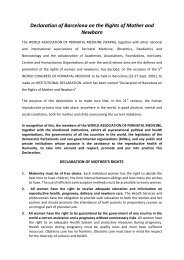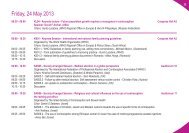Journal of Contraception Reproductive Health Care - The European ...
Journal of Contraception Reproductive Health Care - The European ...
Journal of Contraception Reproductive Health Care - The European ...
Create successful ePaper yourself
Turn your PDF publications into a flip-book with our unique Google optimized e-Paper software.
<strong>The</strong> 8th Congress <strong>of</strong> <strong>The</strong> <strong>European</strong> Society <strong>of</strong> <strong>Contraception</strong> Abstracts <strong>of</strong> Invited Speakers<br />
IS-29<br />
Abstract not available at the time <strong>of</strong> printing<br />
IS-30<br />
New progestins<br />
R. Sitruk-Ware<br />
Rockefeller University and Population Council, New York, USA<br />
<strong>The</strong> progestins have different pharmacologic properties depending upon the parent molecule, usually testosterone or progesterone,<br />
from which they are derived. Very small structural changes in the parent molecule may induce considerable differences<br />
in the activity <strong>of</strong> the derivative. <strong>The</strong> development <strong>of</strong> new generations <strong>of</strong> progestins with improved selectivity pr<strong>of</strong>iles has been a<br />
great challenge. Steroidal and nonsteroidal progesterone receptor agonists have been synthesized as well, although the later are<br />
still in a very early stage <strong>of</strong> development. Several new progestins, which have been synthesized in the last decade, may be<br />
considered fourth-generation progestins. <strong>The</strong>se include dienogest, drospirenone, Nestorone 1 , nomegestrol acetate, and trimegestone.<br />
<strong>The</strong> fourth- generation progestins have been designed to have no androgenic or estrogenic actions and to be closer in<br />
activity to the physiological hormone progesterone. Drospirenone differs from classic progestins as it is derived from spirolactone.<br />
It is essentially an antimineralocorticoid steroid with no androgenic effect but a partial antiandrogenic effect. <strong>The</strong> antiovulatory<br />
potency <strong>of</strong> the different progestins varies. All progestins achieve the expected effect, but the less active compounds require<br />
higher doses to exert antigonadotropic effect. Trimegestone and Nestorone are the most potent progestins synthesized to date,<br />
followed by two <strong>of</strong> the gonanes: keto-desogestrel and levonorgestrel. <strong>The</strong> new molecules drospirenone and dienogest have less<br />
potent antigonadotropic activity and higher doses are required to suppress ovulation. Levonorgestrel, etonogestrel and Nestorone<br />
have been incorporated into long-acting delivery systems for use as long-term progestin-only contraceptives.<br />
Nestorone, has high progestational activity yet is not active orally; it must be administered parenterally due to its rapid hepatic<br />
metabolism. <strong>The</strong> anti-ovulatory potency <strong>of</strong> Nestorone (s.c) is twice greater than levonorgestrel. Due to its high potency, very<br />
low doses <strong>of</strong> Nestorone may be delivered via long-term sustained-release delivery systems. Nestorone, 75 or 100 mg per day,<br />
released by vaginal ring for 6 to 12 months, has suppressed ovulation with inhibition <strong>of</strong> follicular maturation in a high percentage<br />
<strong>of</strong> women. A vaginal ring releasing both 150 mg <strong>of</strong> Nestorone and 15 mg <strong>of</strong> ethinyl estradiol per day has effectively<br />
suppressed ovulation for 13 consecutive cycles. Nestorone has also been used effectively in a single implant for contraception in<br />
breastfeeding women and shows promise for use in transdermal systems as a contraceptive or for hormone therapy.<br />
Natural progesterone and some <strong>of</strong> its derivatives, such as the 19-norprogesterone molecules, and the new molecules drospirenone<br />
and dienogest are not androgenic and, therefore, have no negative effect on the lipid pr<strong>of</strong>ile. <strong>The</strong> antimineralocorticoid<br />
effect <strong>of</strong> drospirenone leading to a better control <strong>of</strong> blood pressure is likely to <strong>of</strong>fer potential cardiovascular benefits and further<br />
studies with this progestin are warranted. <strong>The</strong> effects <strong>of</strong> progestins on breast tissue remain controversial. However, depending on<br />
the progestin and the duration <strong>of</strong> application, cell differentiation and apoptosis may predominate over proliferation. It is still<br />
unclear if the currently available progestins are able to bind specifically to the progesterone receptors PR-A or PR-B and<br />
whether this is <strong>of</strong> clinical relevance to breast cell proliferation is unknown. Further research in this direction is warranted.<br />
26 <strong>The</strong> <strong>European</strong> <strong>Journal</strong> <strong>of</strong> <strong>Contraception</strong> and <strong>Reproductive</strong> <strong>Health</strong> <strong>Care</strong>








